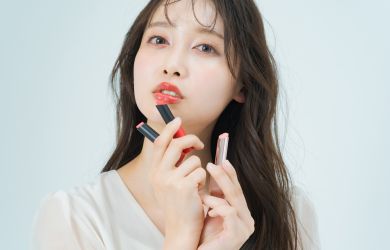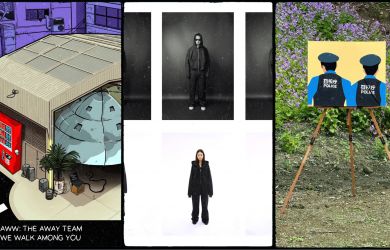
February 17, 2011
At Play with Wisut Ponnimit
The multi-talented foreign manga-ka says he can die happy
By Metropolis
Originally published on metropolis.co.jp on February 2011

Photos by Benjamin Parks
Everyone thought he was bananas, but your aspiring manga-ka buddy Bob may just make it big in Japan. If he does, he’ll be following in the footsteps of Wisut Ponnimit, whose genre-dynamiting manga have garnered a cult following among Tokyo’s 20-somethings. Ponnimit charms readers with stories that blur the borders between art and literature while offering humor, warmth and philosophical accessibility. Older fans—including cultural icons Banana Yoshimoto and Haruomi Hosono—gush about his writings as a source of wonder and inspiration.
Born in Bangkok in 1976, Ponnimit arrived in Japan in 2003 with no knowledge of nihongo. After long days spent tracing kanji in language school, his tireless hands earned him a place in the 2005 Yokohama Triennale, as well as publishing contracts with heavyweights Shinchosha and Shogakukan. Now dividing his time between Bangkok and Tokyo, Ponnimit has released over a dozen avant-garde manga. He also writes an advice column for CUT, draws for The Yomiuri Shimbun, and has a serialized comic in The Big Issue. In his spare time, he holds exhibitions of his manga-style drawings and lithographs; creates anime and their soundtracks; appears on television; plucks his guitar at Tower Records; and will, apparently, break out a Lou Reed number with a little winking and nudging. In other words, we love him and wish he’d live in Tokyo year-round. Winter schminter, Wisut.
We caught up with the Renaissance man during a sold-out portrait-drawing marathon for his fans at Vacant, a gallery, bookstore, restaurant and “creative event space” in Harajuku (pictured opposite).
When did you put your sights on becoming a manga artist?
I had drawn manga from the time I was a kid and would show my friends. Then, when I was in college, an alternative manga magazine just happened to start up. I sent off a comic as an experiment and, well, they published it. When I got paid I thought, “Wow, I can make money from this!” The thing is that in Thailand, there really weren’t manga artists, so I didn’t consider it a possibility. But when I actually made a profit, I realized, “I can do it!”
How did you end up in Japan?
I had been working as a manga artist in Thailand for five years, and once I got sort of famous there, I wanted to go somewhere else. Of course, I’d watched Mickey Mouse and other Disney cartoons, but what I loved growing up was Doraemon. I decided to come to Japan and experience what it’s like here. I never intended to produce manga in Japan. It’s just that I found myself wanting to know about the country responsible for my favorite art.
 How did you find life here just after arriving?
How did you find life here just after arriving?
I went to Kobe and couldn’t speak Japanese, so I studied at a language school. Everyone was so helpful and generous, but it was hard at times. Little things unnerved me—like not being able to read the electricity bill [laughs]. Before long, though, with everyone’s help, I got used to life here.
How would you compare Japan and Thailand?
If you were to live in Thailand, you’d completely change. The meaning of life there isn’t work. All kinds of people just do their own thing. The categories of work are even different. Work in Japan is, well, you know [laughs]. Everyone here is connected to the system. Yet in Thailand, we don’t really have that system, so everyone’s lives are a free-for-all. If you live in Japan, you cave in and, for better or worse, link up. That’s a little different.
What attracts you to Tokyo?
There are brilliant art venues and many beautiful people, but, well, what I love is the clean air [laughs]. You can walk outside! In Bangkok, you’ll walk around for five minutes and already ache to go home. It’s smoldering hot and there is nothing except for dust, stray dogs, food stands and excrement. Bangkok has fun spots too, but there are far more places that aren’t fun. Things are chaotic and cluttered, unlike orderly Tokyo. The sidewalks in Tokyo are like this [wiggles arms gesturing straightness], unlike Bangkok [wiggles arms to gesture chaos]. In any case, I do like life in Bangkok [laughs].
Have you discovered anything new about yourself through the creative process?
I’ve discovered things about myself through my manga and have also changed my manga by discovering things about myself. The illustrations, stories and messages of a book express the life of the author when it was created. So, life influences and inspires me—my average, everyday lifestyle: meeting people, eating meals, doing work and everything else. These things become my art, so when I see my finished works, I perceive how I’ve changed; I see myself reflected in the past. I grow from seeing the former me, which, in and of itself, becomes another experience.
Any turning points in your work?
The character Mamuan. I did a series of books a long time ago titled Hishiitto (“He-She-It”) and loved them. After finishing, I felt satisfied enough to die right then and there. Though I’d accomplished my life’s work, I still had time left to try new pieces. I created a slew of characters, contemplating how different people or animals think. Imagine, for instance, there is a house filled with sheets of glass. A bird can easily enter, but then it can’t get out. Seeing it from the vantage point of a human, it’s easy to call the bird foolish. That was my way of thinking. Yet a bird wouldn’t agree. I’ve become more able to think about that sort of thing, about being the bird. So my perspective has widened, and my turning point was gaining these new perspectives.
What manga artists influenced you?
Mitsuru Adachi and Osamu Tezuka. Particularly the books Niji iro tōgarashi (“Rainbow-Colored Chili Powder”), Burakku Jakku (“Black Jack”), and Hinotori (“Phoenix”). I read Mitsuru Adachi in high school and then Osamu Tezuka in college. Adachi’s Niji iro tōgarashi is so extraordinary. When you read it, everything comes out of the book, into this world. It’s so expansive and beautiful! Tezuka’s manga is not as beautiful, but it is dazzling. In addition, well, you probably can’t see it in my work, but at the foundation of my art is what I encountered as a child: Mickey Mouse, Pink Panther and Doraemon. The anime I make has no dialogue, and I noticed recently, neither did Pink Panther.
What kind of projects would you like to get involved with in the future?
I’ll try anything! I’ve already done what I really wanted to, so I’ll focus on commissioned projects. The scope or nature of a commissioned piece is often something I wouldn’t have imagined myself. I’ve also been trying more exhibitions and, though it isn’t related to manga, play guitar and make music!
Ponnimit picks up an acoustic guitar and begins playing Lou Reed’s “Perfect Day.” We’re baited into his sweet trap and chime in on the chorus: “Oh it’s such a perfect day / I’m glad I spent it with you.”
Fan Talk
 Kaori Tsukada, 25, clerk
Kaori Tsukada, 25, clerk
Wisut’s art is charming and I feel happy looking at it. I want him to draw a cute portrait of me!
 Sano Osamu, 23, cook
Sano Osamu, 23, cook
Wisut warms my heart. His art is abstract but gives me a feeling of nostalgia for some sort of childhood gentleness.
 Rie Yamamoto, 38, designer
Rie Yamamoto, 38, designer
The manga is adorable and makes me feel sparks of tenderness. At times, though, it gets a little raunchy and “male,” but that also somehow touches me.
 Tomoko Baba, 26, editor
Tomoko Baba, 26, editor
I particularly enjoy Wisut’s live performances. The content is so cute, yet they have a lot of depth to offer. They also make me remember things from my childhood, like puppy love.

©Wisut 2010 / OHTA Publishing Company, Japan
Excerpt from Wisut Ponnimit’s Romansu
1: If this were the old days, we’d all stroll past each other on the same sidewalk.
2: Sometimes we’d bump into each other. S-sorry! Sorry!
3: And then, this kind of accident could be the start of love. Wouldn’t you let me get you a cup of tea? Oh well yes, but is that okay?
4: Now, there isn’t any such thing as romance. Tea and whatnot have become capsules.
5: Contemporary science has progressed very much, but…
6: In my case, this lifestyle isn’t at all a happy one.
7: I love things of the past…
8: What’s in vogue now, I have zero interest in. Yet…
9: This newly finished place allows us to see bygone times!

Wisut Ponnimit will hold a solo exhibition next month at Kido Press gallery in Koto-ku.
Kido Press
Mar 5-Apr 9, free. 6F 1-3-2 Kiyosumi, Koto-ku. Tel: 03-5856-5540. Open Tue-Sat noon-7pm, closed Sun-Mon & hols. Nearest stn: Kiyosumi-Shirakawa. www.kidopress.com
He posts a new multilingual animated short every month on the Audio-Technica website: http://meturl.com/wisut Official website: www.soimusic.com/wisut





